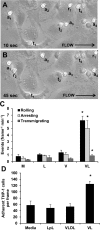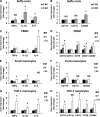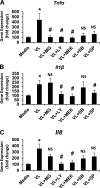Postprandial VLDL lipolysis products increase monocyte adhesion and lipid droplet formation via activation of ERK2 and NFκB
- PMID: 24163071
- PMCID: PMC3920150
- DOI: 10.1152/ajpheart.00137.2013
Postprandial VLDL lipolysis products increase monocyte adhesion and lipid droplet formation via activation of ERK2 and NFκB
Abstract
Postprandial lipemia is characterized by a transient increase in circulating triglyceride-rich lipoproteins such as very low-density lipoprotein (VLDL) and has been shown to activate monocytes in vivo. Lipolysis of VLDL releases remnant particles, phospholipids, monoglycerides, diglycerides, and fatty acids in close proximity to endothelial cells and monocytes. We hypothesized that postprandial VLDL lipolysis products could activate and recruit monocytes by increasing monocyte expression of proinflammatory cytokines and adhesion molecules, and that such activation is related to the development of lipid droplets. Freshly isolated human monocytes were treated with VLDL lipolysis products (2.28 mmol/l triglycerides + 2 U/ml lipoprotein lipase), and monocyte adhesion to a primed endothelial monolayer was observed using a parallel plate flow chamber coupled with a CCD camera. Treated monocytes showed more rolling and adhesion than controls, and an increase in transmigration between endothelial cells. The increased adhesive events were related to elevated expression of key integrin complexes including Mac-1 [α(m)-integrin (CD11b)/β2-integrin (CD18)], CR4 [α(x)-integrin (CD11c)/CD18] and VLA-4 [α4-integrin (CD49d)/β1-integrin (CD29)] on treated monocytes. Treatment of peripheral blood mononuclear cells (PBMCs) and THP-1 monocytes with VLDL lipolysis products increased expression of TNFα, IL-1β, and IL-8 over controls, with concurrent activation of NFkB and AP-1. NFκB and AP-1-induced cytokine and integrin expression was dependent on ERK and Akt phosphorylation. Additionally, fatty acids from VLDL lipolysis products induced ERK2-dependent lipid droplet formation in monocytes, suggesting a link to inflammatory signaling pathways. These results provide novel mechanisms for postprandial monocyte activation by VLDL lipolysis products, suggesting new pathways and biomarkers for chronic, intermittent vascular injury.
Keywords: adhesion molecules; fatty acids; inflammation; lipoprotein lipase.
Figures








Similar articles
-
Fatty acids from very low-density lipoprotein lipolysis products induce lipid droplet accumulation in human monocytes.J Immunol. 2010 Apr 1;184(7):3927-36. doi: 10.4049/jimmunol.0903475. Epub 2010 Mar 5. J Immunol. 2010. PMID: 20208007 Free PMC article.
-
Postprandial lipoproteins and the molecular regulation of vascular homeostasis.Prog Lipid Res. 2013 Oct;52(4):446-64. doi: 10.1016/j.plipres.2013.06.001. Epub 2013 Jun 15. Prog Lipid Res. 2013. PMID: 23774609 Review.
-
Monocyte adhesion and transmigration induce tissue factor expression: role of the mitogen-activated protein kinases.Shock. 2002 Jul;18(1):51-7. doi: 10.1097/00024382-200207000-00010. Shock. 2002. PMID: 12095134
-
Postprandial apoE isoform and conformational changes associated with VLDL lipolysis products modulate monocyte inflammation.PLoS One. 2012;7(11):e50513. doi: 10.1371/journal.pone.0050513. Epub 2012 Nov 28. PLoS One. 2012. PMID: 23209766 Free PMC article.
-
β1- and β2-integrins: central players in regulating vascular permeability and leukocyte recruitment during acute inflammation.Am J Physiol Heart Circ Physiol. 2021 Feb 1;320(2):H734-H739. doi: 10.1152/ajpheart.00518.2020. Epub 2020 Dec 18. Am J Physiol Heart Circ Physiol. 2021. PMID: 33337960 Free PMC article. Review.
Cited by
-
Modified Lipoproteins Induce Arterial Wall Inflammation During Atherogenesis.Front Cardiovasc Med. 2022 Mar 3;9:841545. doi: 10.3389/fcvm.2022.841545. eCollection 2022. Front Cardiovasc Med. 2022. PMID: 35310965 Free PMC article. Review.
-
Role of LpL (Lipoprotein Lipase) in Macrophage Polarization In Vitro and In Vivo.Arterioscler Thromb Vasc Biol. 2019 Oct;39(10):1967-1985. doi: 10.1161/ATVBAHA.119.312389. Epub 2019 Aug 22. Arterioscler Thromb Vasc Biol. 2019. PMID: 31434492 Free PMC article.
-
Inhibition of perilipin 2 expression reduces pro-inflammatory gene expression and increases lipid droplet size.Food Funct. 2018 Dec 13;9(12):6245-6256. doi: 10.1039/c8fo01420e. Food Funct. 2018. PMID: 30402637 Free PMC article.
-
Oleanolic Acid-Enriched Olive Oil Alleviates the Interleukin-6 Overproduction Induced by Postprandial Triglyceride-Rich Lipoproteins in THP-1 Macrophages.Nutrients. 2021 Sep 29;13(10):3471. doi: 10.3390/nu13103471. Nutrients. 2021. PMID: 34684472 Free PMC article.
-
Obese Mice Losing Weight Due to trans-10,cis-12 Conjugated Linoleic Acid Supplementation or Food Restriction Harbor Distinct Gut Microbiota.J Nutr. 2018 Apr 1;148(4):562-572. doi: 10.1093/jn/nxy011. J Nutr. 2018. PMID: 29659960 Free PMC article.
References
-
- Ali S, Mann DA. Signal transduction via the NF-kappaB pathway: a targeted treatment modality for infection, inflammation and repair. Cell Biochem Funct 22: 67–79, 2004 - PubMed
-
- Alipour A, van Oostrom AJ, Izraeljan A, Verseyden C, Collins JM, Frayn KN, Plokker TW, Elte JW, Castro Cabezas M. Leukocyte activation by triglyceride-rich lipoproteins. Arterioscler Thromb Vasc Biol 28: 792–797, 2008 - PubMed
-
- Bermudez B, Lopez S, Varela LM, Ortega A, Pacheco YM, Moreda W, Moreno-Luna R, Abia R, Muriana FJ. Triglyceride-rich lipoprotein regulates APOB48 receptor gene expression in human THP-1 monocytes and macrophages. J Nutr 142: 227–232, 2012 - PubMed
-
- Bouwens M, Grootte Bromhaar M, Jansen J, Müller M, Afman LA. Postprandial dietary lipid-specific effects on human peripheral blood mononuclear cell gene expression profiles. Am J Clin Nutr 91: 208–217, 2010 - PubMed
Publication types
MeSH terms
Substances
Grants and funding
LinkOut - more resources
Full Text Sources
Other Literature Sources
Research Materials
Miscellaneous

